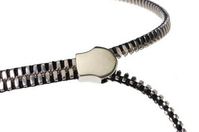








A zipper, zip, fly or zip fastener, formerly known as a clasp locker, is a commonly used device for binding the edges of an opening of fabric or other flexible material, as on a garment or a bag.It is used in clothing (e.g., jackets and jeans), luggage and other bags, sporting goods, camping gear (e.g. tents and sleeping bags), and other items. Whitcomb L. Judson was an American inventor from Chicago who was the first to invent, conceive of the idea, and to construct a workable zipper.The method, still in use today, is based on interlocking teeth. Initially it was called the “hookless fastener” and was later redesigned to become more reliable.
In 1851, Elias Howe received a patent for an "Automatic, Continuous Clothing Closure". He did not try seriously to market it, missing recognition he might otherwise have received.Howe's device was more like an elaborate draw-string than a true slide fastener.
Forty-two years later, Whitcomb Judson, who invented a pneumatic street railway, marketed a "Clasp Locker". The device served as a (more complicated) hook-and-eye shoe fastener. With the support of businessman Colonel Lewis Walker, Judson launched the Universal Fastener Company to manufacture the new device. The clasp locker had its public debut at the 1893 Chicago World's Fair and met with little commercial success.Judson is sometimes given credit as the inventor of the zipper, but he never made a practical device.
The company, reorganized as the "Fastener Manufacturing and Machine Company," moved to Hoboken, N.J. in 1901. Gideon Sundback, a Swedish-American electrical engineer, was hired to work for the company in 1906. Good technical skills and a marriage to the plant-manager's daughter Elvira Aronson led Sundbäck to the position of head designer. The company moved to Meadville, PA, where it operated for most of the 20th century under the name "Talon, Inc." After his wife's death in 1911, Sundback devoted himself to improving the fastener, and by December 1913 he had designed the modern zipper. The rights to this invention were owned by the Meadville company (operating as the "Hookless Fastener Co."), but Sundback retained non-U.S. rights and used these to set up in subsequent years the Canadian firm ‘Lightning Fastner Co.’ in St. Catharines, Ont. Sundback's work with this firm has led to the common misperception that he was Canadian and that the zipper originated in that country.
Gideon Sundback increased the number of fastening elements from four per inch (about one every 6.4 mm) to ten or eleven (around every 2.5 mm), introduced two facing rows of teeth that pulled into a single piece by the slider, and increased the opening for the teeth guided by the slider. The patent for the "Separable Fastener" was issued in 1917. Gideon Sundback also created the manufacturing machine for the new device. The "S-L" or "scrapless" machine took a special Y-shaped wire and cut scoops from it, then punched the scoop dimple and nib, and clamped each scoop on a cloth tape to produce a continuous zipper chain. Within the first year of operation, Sundback's machinery was producing a few hundred feet (around 100 meters) of fastener per day.[citation needed] In March of the same year, Mathieu Burri, a Swiss inventor, improved the design by adding a lock-in system attached to the last teeth, but his version never got into production due to conflicting patents.
The popular North American term zipper, (UK zip, or occasionally zip-fastener), came from the B. F. Goodrich Company in 1923. The company opted to use Gideon Sundback's fastener on a new type of rubber boots (or galoshes) and referred to it as the zipper, and the name stuck. The two chief uses of the zipper in its early years were for closing boots and tobacco pouches. Zippers began being used for clothing in 1925 by Schott NYC on leather jackets.
In the 1930s, a sales campaign began for children's clothing featuring zippers. The campaign praised zippers for promoting self-reliance in young children by making it possible for them to dress in self-help clothing. The zipper beat the button in 1937 in the "Battle of the Fly", after French fashion designers raved over zippers in men's trousers. Esquire declared the zipper the "Newest Tailoring Idea for Men" and among the zippered fly's many virtues was that it would exclude "The Possibility of Unintentional and Embarrassing Disarray."
The most recent innovation[citation needed] in the zipper's design was the introduction of models that could open on both ends, as on jackets. Today the zipper is by far the most widespread fastener, and is found on clothing, luggage, leather goods, and various other objects.